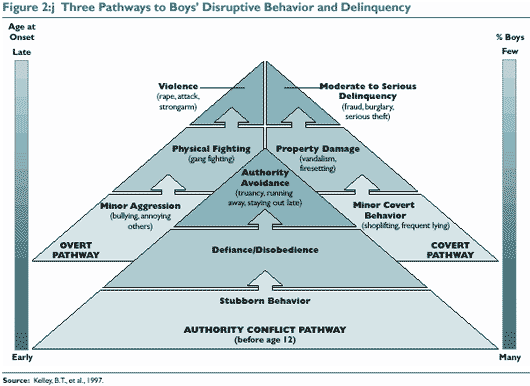Chapter 2: Jurisdictional and Program Self-Assessment
What Prompts Juvenile Delinquency
Although the roots of youth crime may be quite different from one youth to another, recent research has helped focus much more sharply on major underlying issues that often cause or are related to delinquent behavior. Blumstein (1995) attributes recent dramatic upturns in youth violence to the "deadly nexus" of three primary factors:
- Availability of drugs.
- Availability of guns.
- Juveniles recruited into illicit drug trade.
In addition to the availability of drugs and guns, OJJDP (1997a) describes several other factors that contribute to delinquency, including:
- Too much idle time for children and adolescents.
- Lack of positive adult supervision.
- Scarcity of positive role models.
- Child abuse and neglect.
- Parents who lack needed parenting skills.
- Children with unmet needs for special education and mental health care.
Several conditions, attitudes, and behaviors increase the likelihood that a young person will engage in delinquent behavior. Many of these factors also are related to other adolescent problem behaviors, including substance abuse, teenage pregnancy, dropping out of school, and violence. Researchers assert that the more risk factors that are present, the greater the likelihood for juvenile problem behavior. Furthermore, effects of risk factors are consistent among youth of different races and cultures (Office of Juvenile Justice and Delinquency Prevention, 1997b).
Concurrently, there are factors that may provide protection to youth to help them surmount risk factors that may be present. To the extent that these protective factors can be enhanced, youth may be safeguarded from some of the effects of risk factors. Table 2:g lists primary risk and protective factors that have been identified through research.
|
Table 2:g Risk and Protective Factors of Delinquency and Other Youth Problems
Risk Factors Community
Environment
Sources: Hawkins, J.D., Catalano, R.F., and Miller, J.Y., 1992:64–105; Catalano, R.F., and Hawkins, J.D., 1995.
|
The Integrated Social Control model combines control theory, strain theory, and social learning theory to explain the origins of delinquent behavior (Elliott, Huizinga, and Ageton, 1985; Krisberg et al., 1994). Families, communities, and society usually exert social control to compel individuals to act in socially acceptable ways. According to this theory, when these controls are absent, subcultures develop that promote attitudes and perceptions favorable to delinquency and other deviant behavior. Differences between a youth's aspirations and his or her opportunities cause frustration and failure. Strain theory argues that youth then turn to delinquent behavior as a way of coping. Social learning theory assumes that childhood experiences, such as lax or harsh parental discipline, abuse, neglect, or violence, prevent bonding with others and diminish internal self-control (Krisberg et al., 1994).
Researchers suggest that there are three pathways through which male youth develop problem behavior. The Authority Conflict Pathway begins before age 12 and consists of a progression from stubborn behavior to defiance and disobedience to authority avoidance. Examples of authority-avoidance behaviors include truancy, running away, and staying out late. The Covert Pathway begins with minor covert behavior, such as shoplifting and frequent lying, progresses to property damage, and eventually leads to moderate to serious delinquency. Fraud, burglary, and serious thefts might fall in this group. The Overt Pathway may start with minor aggression, such as bullying or annoying others. Physical fighting may follow and eventually lead to serious violent acts, such as rapes and assaults. Progress from the initial to later stages of these pathways is not universal. Youth may show early signs of problem behavior but not progress further along these delinquency pathways. Some youth also may progress in more than one of the pathways described (Huizinga, Loeber, and Thornberry, 1995). Figure 2:j graphically depicts these pathways to delinquency based on the work of Kelley et al. (1997).

Similar research on pathways of delinquency for female youth has not been completed. Girls traditionally have constituted a small portion of the juvenile delinquent population and, therefore, have been the subjects of much less research. Recently, however, increasing numbers of females have entered the juvenile justice system, and research agendas comparable to those for males are needed.
| Jurisdictional Technical Assistance Package for Juvenile Corrections | Report - December 2000 |